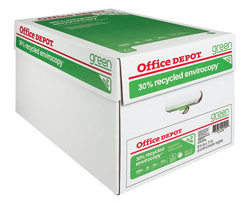
Since early May, when a new paper pricing agreement made Green Top 30% recycled paper less expensive than Red Top non-recycled paper, recycled-content paper has skyrocketed from 10% to almost 80% of total paper purchases across the campus.
30% recycled paper is indistinguishable in quality and performance from virgin paper, but its environmental benefits are enormous. Last year, Notre Dame purchased 6,215 boxes, or over 31 million sheets, of Red Top. Switching all of these purchases to Green Top will save over 500 trees, avoid 39,000 pounds of carbon dioxide emissions, and save 163,000 gallons of water. After only two months at the new pricing, we are well on our way to that goal.
The change in pricing has resulted from a partnership between Notre Dame’s Procurement Services office, which has placed an increasing emphasis on sustainability in negotiating recent supplier contracts, and Office Depot’s corporate sustainability program.
“We’re excited that we were able to work with Office Depot to offer a lower price for the Green Top paper,” said Javier Hernandez, the Procurement Specialist responsible for paper purchasing at Notre Dame. “Considering how much printing we do here on campus, I think this will be a great way to curb the overall environmental footprint of the University and expand the use of recycled products.”
Although the market price for all paper increased significantly over the last year, Notre Dame’s contract with Office Depot had locked in prices until now. The Procurement team worked to limit price increases across all products, but chose to concentrate the unavoidable price increase in the Red Top paper so that departments on campus could make the right choice both environmentally and economically. As a result of these negotiations, the price of Green Top paper has seen a decrease.
In addition to switching any Red Top purchases to Green Top, departments can realize environmental benefits and cost savings by moving away from ultra-bright paper and by always purchasing by the box rather than by individual reams. Ultra-bright paper, in addition to costing extra, produces more pollution than regular paper because of the additional bleaching process involved.